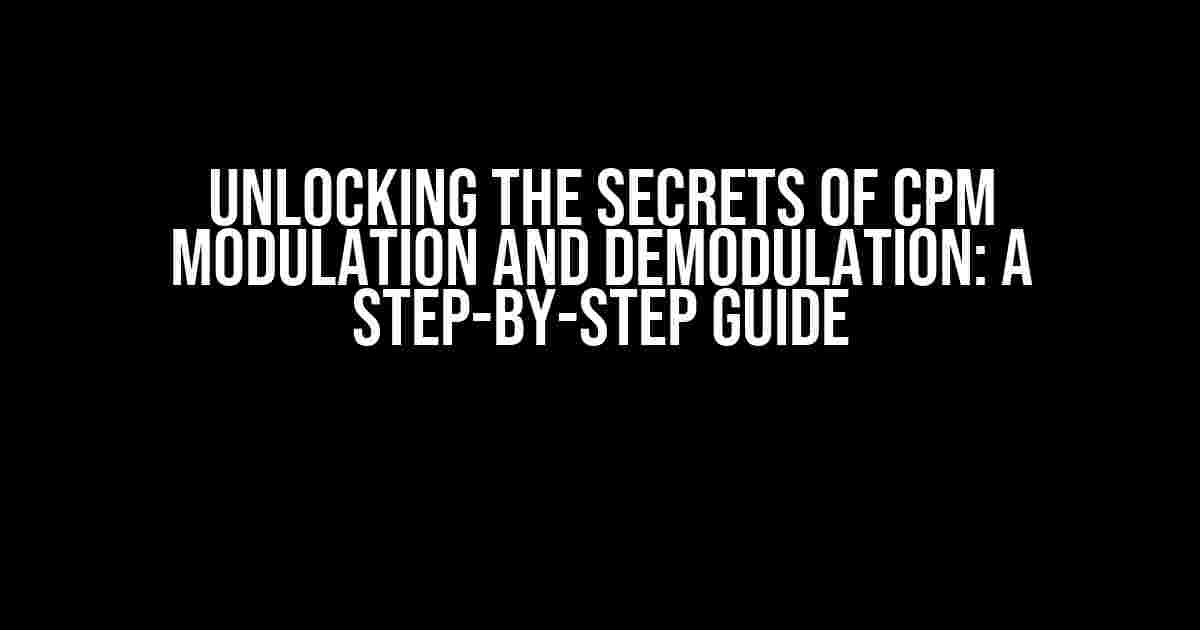Continuous Phase Modulation (CPM) is a popular modulation technique used in various communication systems, including satellite communication, mobile communication, and wireless local area networks (WLANs). In this article, we’ll delve into the world of CPM modulation and demodulation, focusing on how to find the sampling rate to determine the Power Spectral Density (PSD) of the modulated signal.
What is CPM Modulation?
CPM is a type of frequency modulation where the frequency of the carrier wave is varied in accordance with the message signal, resulting in a continuous phase change. This modulation technique is known for its high spectral efficiency and resistance to noise and interference.
Why is CPM Modulation Important?
- High spectral efficiency: CPM modulation allows for a higher data rate transmission with a smaller bandwidth, making it an attractive option for modern communication systems.
- Resistance to noise and interference: CPM modulation is less susceptible to noise and interference, ensuring a more reliable transmission.
- Simple demodulation: CPM modulation enables simple and efficient demodulation, reducing the complexity of the receiver.
CPM Demodulation: A Brief Overview
CPM demodulation involves recovering the original message signal from the modulated signal. The demodulation process typically involves the following steps:
- Filtering: The modulated signal is filtered to remove noise and interference.
- Sampling: The filtered signal is sampled at regular intervals to obtain a discrete-time signal.
- Demodulation: The sampled signal is then demodulated to recover the original message signal.
Finding the Sampling Rate for CPM Modulation
To determine the Power Spectral Density (PSD) of the modulated signal, we need to find the sampling rate for CPM modulation. The sampling rate depends on the bandwidth of the modulated signal, which in turn depends on the modulation index and the symbol rate.
Modulation Index and Symbol Rate
The modulation index (h) is a critical parameter in CPM modulation, defined as the ratio of the frequency deviation to the symbol rate. The symbol rate (Rs) is the rate at which the message signal is transmitted.
h = Δf / Rs
where Δf is the frequency deviation.
Bandwidth of the Modulated Signal
The bandwidth of the modulated signal (BW) can be approximated using the following equation:
BW ≈ 2 \* (Rs + Δf)
Sampling Rate Calculation
The sampling rate (Fs) must be at least twice the bandwidth of the modulated signal to satisfy the Nyquist criterion:
Fs ≥ 2 \* BW
Substituting the bandwidth equation, we get:
Fs ≥ 4 \* (Rs + Δf)
The sampling rate can be further optimized by considering the roll-off factor (α) of the transmitter filter:
Fs ≥ 4 \* (Rs + Δf) / (1 - α)
Power Spectral Density (PSD) of the Modulated Signal
Once the sampling rate is determined, we can calculate the PSD of the modulated signal using the following equation:
PSD(f) = (A^2 / 4) \* sinc^2((f - f_c) / Fs)
where A is the amplitude of the modulated signal, f_c is the carrier frequency, and sinc(x) is the sinc function.
PSD Calculation Example
Let’s consider an example to illustrate the PSD calculation. Assume we have a CPM modulation system with the following parameters:
| Parameter | Value |
|---|---|
| Modulation index (h) | 0.5 |
| Symbol rate (Rs) | 10 kHz |
| Frequency deviation (Δf) | 2 kHz |
| Roll-off factor (α) | 0.5 |
| Carrier frequency (f_c) | 100 kHz |
First, we calculate the bandwidth of the modulated signal:
BW ≈ 2 \* (10 kHz + 2 kHz) = 24 kHz
Next, we calculate the sampling rate:
Fs ≥ 4 \* (10 kHz + 2 kHz) / (1 - 0.5) = 64 kHz
Finally, we calculate the PSD of the modulated signal:
PSD(f) = (A^2 / 4) \* sinc^2((f - 100 kHz) / 64 kHz)
Conclusion
In this article, we’ve explored the world of CPM modulation and demodulation, focusing on how to find the sampling rate to determine the Power Spectral Density of the modulated signal. By following the steps outlined in this article, you’ll be well-equipped to design and implement CPM modulation systems with confidence.
Key Takeaways
- CPM modulation is a popular modulation technique used in various communication systems.
- The sampling rate for CPM modulation depends on the bandwidth of the modulated signal, which in turn depends on the modulation index and symbol rate.
- The Power Spectral Density of the modulated signal can be calculated using the sampling rate and modulation parameters.
With a deep understanding of CPM modulation and demodulation, you’ll be able to unlock the full potential of this powerful modulation technique and take your communication system to the next level.
Frequently Asked Question
Get ready to dive into the world of CPM modulation and demodulation, and learn how to find the sampling rate to calculate the power spectral density of the modulated signal!
What is CPM modulation, and how does it differ from other modulation techniques?
CPM (Continuous Phase Modulation) is a type of modulation technique that encodes information in the phase of the carrier signal. Unlike other modulation techniques like AM or FM, CPM modulation uses a continuous phase variation to convey information, resulting in a more efficient use of bandwidth and better noise immunity.
How does CPM demodulation work, and what are the key challenges involved?
CPM demodulation involves detecting the phase variations of the received signal to recover the original information. The key challenges in CPM demodulation include dealing with phase ambiguity, noise, and interference. One common approach is to use a detector that correlates the received signal with a known reference signal, and then estimates the phase difference to recover the original data.
What is the power spectral density (PSD) of a CPM modulated signal, and why is it important?
The power spectral density (PSD) of a CPM modulated signal represents the distribution of power across different frequency components. PSD is important because it determines the bandwidth occupancy and out-of-band emission of the modulated signal, which in turn affect the system’s performance and compliance with regulatory requirements.
How do I find the sampling rate required to calculate the power spectral density of a CPM modulated signal?
To find the sampling rate, you need to consider the bandwidth of the modulated signal and the desired frequency resolution for the PSD calculation. A general rule of thumb is to choose a sampling rate that is at least twice the bandwidth of the modulated signal. Additionally, you may want to oversample to improve the frequency resolution and reduce aliasing effects.
What are some common tools or software used to analyze and visualize the power spectral density of CPM modulated signals?
Some popular tools and software for PSD analysis and visualization include MATLAB, Python with libraries like SciPy and NumPy, and specialized tools like GNU Radio and Simulink. These tools allow you to generate CPM signals, calculate the PSD, and visualize the results using various plotting and visualization techniques.


